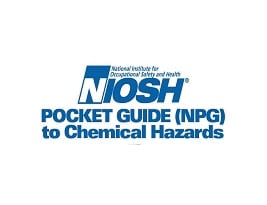Arsenic

Overview
CAS No. 7440-38-2
Arsenic (As) is a white to gray, brittle solid. It occurs naturally in water and soil. Arsenic can be harmful to the eyes, skin, liver, kidneys, lungs, and lymphatic system. Exposure to arsenic can also cause cancer. Workers may be harmed from exposure to arsenic. The level of exposure depends upon the dose, duration, and work being done.
Arsenic is used in many industries. It is used in some paints, wood preservatives, agricultural chemicals, and in glass manufacturing. Some examples of workers at risk of being exposed to arsenic include the following:
- Agricultural or farm workers exposed to some farming chemicals
- Employees involved in glass manufacturing
- Construction and mine workers exposed to arsenic-containing soil
- Recyclers exposed to electronic or e-waste
- Workers who perform nonferrous smelting—a process to extract metal from ore
NIOSH recommends that employers use Hierarchy of Controls to prevent injuries. If you work in an industry that uses arsenic, please read chemical labels and the accompanying Safety Data Sheets for hazard information. Visit NIOSH’s page on Managing Chemical Safety in the Workplace to learn more about controlling chemical workplace exposures.
The following resources provide information about occupational exposure to arsenic. Useful search terms for arsenic include “arsenia” and “arsenic metal.”
NIOSH Chemical Resources
Related NIOSH Resources
- NIOSHTIC-2 search results on arsenic—NIOSHTIC-2 is a searchable database of worker safety and health publications, documents, grant reports, and journal articles supported in whole or in part by NIOSH.
- Immediately Dangerous to Life or Health (IDHL) Value Profile: Arsenic (inorganic compounds, as As)—NIOSH reviews relevant scientific data and researches methods for developing IDLH values.
- NIOSH Worker Health Study Summaries—NIOSH conducts research to prevent illnesses and injuries in the workplace. The NIOSH Worker Notification Program notifies workers and other stakeholders about the findings of these research studies.
Selected Publications
- NIOSH Criteria for a Recommended Standard: Occupational Exposure Standard for Arsenic—DHHS (NIOSH) Publication No. 75-149. This report increases awareness and recommends work practices to reduce exposures.
- NIOSH Skin Notation (SK) Profiles: Arsenic and Inorganic Arsenic Containing Compounds—DHHS (NIOSH) Publication No. 2017-184.
- NIOSH Occupational Safety and Health Guidelines for Arsenic—This guideline summarizes pertinent information about inorganic arsenic for workers, employees, and health and safety professionals.
- Elements, Arsenic, by ICP (Aqua Regia Ashing) No. 7301—Sampling and measurement, NMAM, fourth edition.
- Elements, Arsenic, by ICP (Hotblock/HCL/HNO3 Digestion) No. 7303—Sampling and measurement, NMAM, fourth edition.
- Elements on Wipes, Arsenic No. 9102—Sampling and measurement, NMAM, fourth edition.
Related Resources
- ATSDR ToxFAQs for Arsenic
- ATSDR Case Study in Environmental Medicine: Arsenic Toxicity
- ATSDR Toxicological Profile for Arsenic
- EPA Chemistry Dashboard: Arsenicexternal icon
- EPA Hazard Summary: Arsenic Compoundsexternal icon
- EPA Integrated Risk Information System (IRIS): Arsenic, Inorganicexternal icon
- NLM Haz-Map: Arsenicexternal icon
- NLM TOXNET: Arsenic, Elementalexternal icon
- NTP Report on Carcinogens, Fourteenth Edition: Arsenic and Inorganic Arsenic Compoundsexternal icon
- OSHA Occupational Chemical Database: Arsenicexternal icon
- OSHA Hazard Communicationexternal icon
- OSHA Safety and Health Topic: Arsenicexternal icon
- Risk Assessment Information System (RAIS): Arsenicexternal icon
- New Jersey Hazardous Substance Fact Sheets: Arsenicexternal icon
- American Cancer Society: Arsenic and Cancer Riskexternal icon
International Resources
- Canadian Centre for Occupational Health and Safety (CCOHS): Arsenicexternal icon
- European Chemicals Agency (ECHA)external icon
- Gestis Substance Databaseexternal icon
- IARC Monograph Vol 100C: Arsenicexternal icon
- International Chemical Safety Card: Arsenicexternal icon
- IPCS INCHEM Environmental Health Criteria 18: Arsenicexternal icon
- OECD Global Portal to Information on Chemical Substancesexternal icon
- WHO IARC Monographs Vol. 100C: Arsenic and Arsenic Compoundsexternal icon



